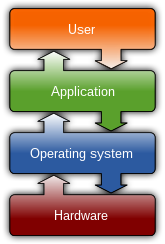
Back Interrupt Amharic مقاطعة (حوسبة) Arabic Aparat kəsilməsi Azerbaijani Прекъсване (компютри) Bulgarian Prekid (računarstvo) BS Interrupció Catalan ناوبڕ CKB Přerušení Czech Interrupt Danish Interrupt German
This article needs additional citations for verification. (February 2014) |
| Operating systems |
|---|
 |
| Common features |

In digital computers, an interrupt (sometimes referred to as a trap)[1] is a request for the processor to interrupt currently executing code (when permitted), so that the event can be processed in a timely manner. If the request is accepted, the processor will suspend its current activities, save its state, and execute a function called an interrupt handler (or an interrupt service routine, ISR) to deal with the event. This interruption is often temporary, allowing the software to resume[a] normal activities after the interrupt handler finishes, although the interrupt could instead indicate a fatal error.[2]
Interrupts are commonly used by hardware devices to indicate electronic or physical state changes that require time-sensitive attention. Interrupts are also commonly used to implement computer multitasking and system calls, especially in real-time computing. Systems that use interrupts in these ways are said to be interrupt-driven.[3]
- ^ "The Jargon File, version 4.4.7". 2003-10-27. Retrieved 20 January 2022.
- ^ Jonathan Corbet; Alessandro Rubini; Greg Kroah-Hartman (2005). "Linux Device Drivers, Third Edition, Chapter 10. Interrupt Handling" (PDF). O'Reilly Media. p. 269. Retrieved December 25, 2014.
Then it's just a matter of cleaning up, running software interrupts, and getting back to regular work. The "regular work" may well have changed as a result of an interrupt (the handler could
wake_upa process, for example), so the last thing that happens on return from an interrupt is a possible rescheduling of the processor. - ^ Rosenthal, Scott (May 1995). "Basics of Interrupts". Archived from the original on 2016-04-26. Retrieved 2010-11-11.
Cite error: There are <ref group=lower-alpha> tags or {{efn}} templates on this page, but the references will not show without a {{reflist|group=lower-alpha}} template or {{notelist}} template (see the help page).